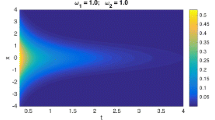Abstract
We propose a method for stably removing noise from measurements of a quantum many-body system. The question is cast to a linear inverse problem by using a quantum Fischer information metric as figure of merit. This requires the ability to compute the adjoint of the noise channel with respect to the metric, which can be done analytically when the metric is evaluated at a Gaussian (quasi-free) state. This approach can be applied effectively to n-point functions of a quantum field theory. For translation invariant noise, this yields a stable deconvolution method on the first moments of the field which differs from what one would obtain from a purely classical analysis.

Similar content being viewed by others
References
Ferrie, C., Blume-Kohout, R.: Estimating the bias of a noisy coin. In: AIP Conference Proceedings 31st, vol. 1443, pp. 14–21. AIP (2012). arXiv:1201.1493
Bény, C., Osborne, T.J.: The renormalization group via statistical inference. New J. Phys. 17, 083005 (2015). arXiv:1402.4949
Bény, C.: Coarse-grained distinguishability of field interactions. (2015). arXiv:1509.03249
Petz, D.: Monotone metrics on matrix spaces. Linear Algebra Appl. 244, 81 (1996)
Petz, D.: A dual in von Neumann algebras with weights. Q. J. Math. 35, 475 (1984)
Lami, L., Das, S., Wilde, M.M.: Approximate reversal of quantum Gaussian dynamics. (2017). arXiv:1702.04737
Gonzalez, R.C.E., Woods, S.L., Gonzalez, R.E.R.E.R.C., Woods, R.E., Eddins, S.L.: Digital image processing using MATLAB, 04; TA1637, G6 (2004)
Petz, D.: Sufficiency of channels over von Neumann algebras. Q. J. Math. 39, 97 (1988)
Barnum, H., Knill, E.: Reversing quantum dynamics with near-optimal quantum and classical fidelity. J. Math. Phys. 43, 2097 (2002). arXiv:quant-ph/0004088
Fawzi, O., Renner, R.: Quantum conditional mutual information and approximate Markov chains. Commun. Math. Phys. 340, 575 (2015). arXiv:1410.0664
Junge, M., Renner, R., Sutter, D., Wilde, M.M., Winter, A.: Universal recoverability in quantum information. In: 2016 IEEE International Symposium on Information Theory (ISIT), pp. 2494–2498. IEEE (2016)
Sutter, D., Tomamichel, M., Harrow, A.W.: Strengthened monotonicity of relative entropy via pinched Petz recovery map. IEEE Trans. Inf. Theory 62, 2907 (2016). arXiv:1507.00303
Acknowledgements
This work was supported by the research fund of Hanyang University (HY-2016-2237).
Author information
Authors and Affiliations
Corresponding author
Appendix
Appendix
Here we derive Eq. (5). We do the calculation in terms of the dual metric
which we extended to non-hermitian operators. With \(\Omega _\rho (X) = \sqrt{\rho }X \sqrt{\rho }\), this is
We observe that if we write \(\rho \) as a Gibbs state for a quadratic Hamiltonian H, i.e. as \(\rho \propto \mathrm{e}^{-H}\), then
This is the imaginary time evolution generated by the Hamiltonian H. On a single canonical operator \(\phi (f)\), we have \(\rho ^{s} \phi (f) \rho ^{-s} = \phi (R_{s}^A f)\) where \(R_{-it}^A\) is the linear phase-space evolution matrix corresponding to the quadratic Hamiltonian H for time t. Here A denotes the state’s covariance matrix, which also uniquely defines H.
The slight difficulty this introduces is that \(R_{s}^A\) acts on a complexification of the phase space. We do not mean the usual technique of treating half of the phase-space variables as imaginary, which would yield an n-dimensional complex vector space from a 2n-dimensional real phase space. Instead, we simply allow all the vector coefficients to be complex, which yields a 2n-dimensional complex vector space.
In terms of the normal-ordered displacement operators \(G_f^A\), this is
Therefore, the dual metric can be computed via
We need to be careful about how the displacement operators behave on the complexified phase space. We have
where the phase-space scalar product is extended so as to be conjugate-symmetric. For instance, this implies
where the overline denotes complex conjugation component-wise. It follows that
The adjointness relation defining \(\mathcal N_*\) reads
where A is the covariance matrix for \(\rho \) and B is the covariance matrix for \(\mathcal N(\rho )\), namely \(B = X^\dagger A X + Y\). Using
and Eq. (14), we obtain
Hence, with the ansatz
Eq. (15) is satisfied if
for all f, g, which implies
or
To obtain the form of Eq. (5), we use the fact that \((R^A_s)^{-1} = R^A_{-s} = \overline{R^A_s}\), which can be seen for instance from the explicit expression Eq. (7). We also use the fact that the covariance matrix and symplectic structure are invariant under \(R_s\), i.e. such that \((R^A_s)^T(A+ \tfrac{i}{2} \Delta ) R^A_s = (A+ \tfrac{i}{2} \Delta )\). From these properties it follows that
which yields
Rights and permissions
About this article
Cite this article
Bény, C. Quantum deconvolution. Quantum Inf Process 17, 26 (2018). https://doi.org/10.1007/s11128-017-1796-3
Received:
Accepted:
Published:
DOI: https://doi.org/10.1007/s11128-017-1796-3




